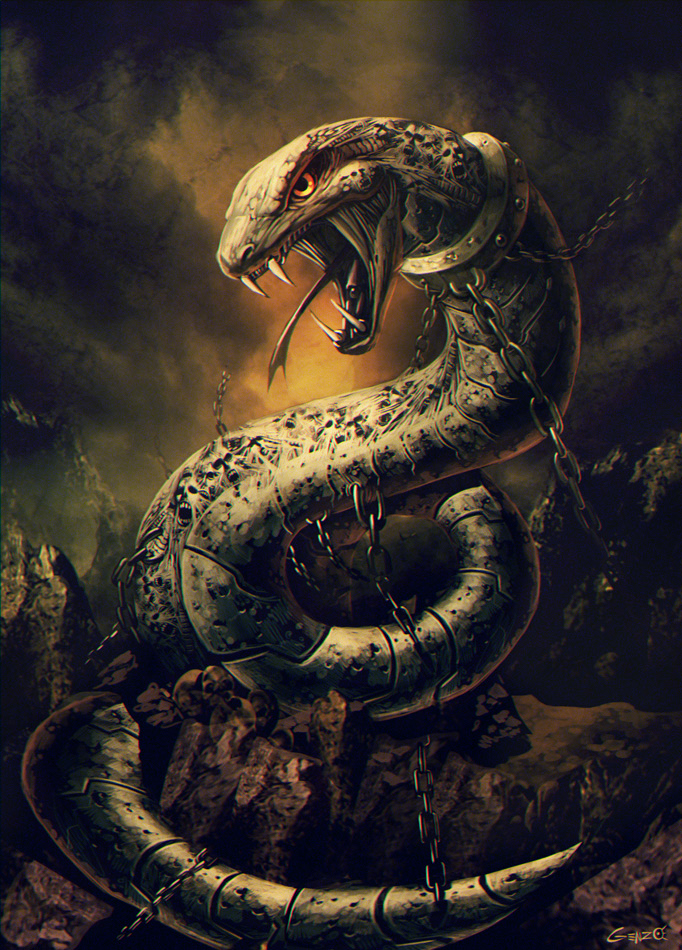ShopDreamUp AI ArtDreamUp
Deviation Actions
Suggested Deviants
Suggested Collections
You Might Like…
Featured in Groups
Description
Hi guys! this is an old image done some years ago. I hope you like it 
PSCS/graphire 2/6hours/music: Treasury Room - Super Castlevania IV
www.youtube.com/watch?v=h4VF0m…
--------------------------------------------------------------------------
LETS WIKIATTACK!
In Norse mythology, Níðhöggr (Malice Striker, often anglicized Nidhogg) is a dragon who gnaws at a root of the world tree, Yggdrasil. In historical Viking society, níð was a term for a social stigma implying the loss of honor and the status of a villain. Thus, its name might refer to its role as a horrific monster or in its action of chewing the corpses of the inhabitants of Náströnd: those guilty of murder, adultery, and oath-breaking, which Norse society considered among the worst possible crimes.
According to the Gylfaginning part of Snorri Sturluson's Prose Edda, Níðhöggr is a being which gnaws one of the three roots of Yggdrasill. It is sometimes believed that the roots are trapping the beast from the world. This root is placed over Niflheimr and Níðhöggr gnaws it from beneath. The same source also says that "The squirrel called Ratatöskr runs up and down the length of the Ash, bearing envious words between the eagle and Nídhöggr". In the Skáldskaparmál section of the Prose Edda Snorri specifies Níðhöggr as a serpent in a list of names of such creatures: These are names for serpents: dragon, Fafnir, Iormungand, adder, Nidhogg, snake, viper, Goin, Moin, Grafvitnir, Grabak, Ofnir, Svafnir, masked one. Snorri's knowledge of Níðhöggr seems to come from two of the Eddic poems: Grímnismál and Völuspá. Later in Skáldskaparmál, Snorri includes Níðhöggr in a list of various terms and names for swords.
The poem Grímnismál identifies a number of beings which live in Yggdrasill. The tree suffers great hardship from all the creatures which live on it. The poem identifies Níðhöggr as tearing at the tree from beneath and also mentions Ratatoskr as carrying messages between Níðhöggr and the eagle who lives at the top of the tree. Snorri Sturluson often quotes Grímnismál and clearly used it as his source for this information. The poem Völuspá mentions Níðhöggr twice. The first instance is in its description of Náströnd.
"A hall I saw,far from the sun,On Nastrond it stands,and the doors face north,Venom dropsthrough the smoke-vent down,For around the wallsdo serpents wind. I there saw wadingthrough rivers wildtreacherous menand murderers too,And workers of illwith the wives of men;There Nithhogg suckedthe blood of the slain,And the wolf tore men;would you know yet more?"
The most prevalent opinion is that the arrival of Níðhöggr heralds Ragnarök and thus that the poem ends on a tone of ominous warning.
--------------------------
You can share my art! Thanks
--------------------------
-FACEBOOK
-TUMBLR
-TWITTER
-LIVESTREAM
-PIXIV
PSCS/graphire 2/6hours/music: Treasury Room - Super Castlevania IV
www.youtube.com/watch?v=h4VF0m…
--------------------------------------------------------------------------
LETS WIKIATTACK!
In Norse mythology, Níðhöggr (Malice Striker, often anglicized Nidhogg) is a dragon who gnaws at a root of the world tree, Yggdrasil. In historical Viking society, níð was a term for a social stigma implying the loss of honor and the status of a villain. Thus, its name might refer to its role as a horrific monster or in its action of chewing the corpses of the inhabitants of Náströnd: those guilty of murder, adultery, and oath-breaking, which Norse society considered among the worst possible crimes.
According to the Gylfaginning part of Snorri Sturluson's Prose Edda, Níðhöggr is a being which gnaws one of the three roots of Yggdrasill. It is sometimes believed that the roots are trapping the beast from the world. This root is placed over Niflheimr and Níðhöggr gnaws it from beneath. The same source also says that "The squirrel called Ratatöskr runs up and down the length of the Ash, bearing envious words between the eagle and Nídhöggr". In the Skáldskaparmál section of the Prose Edda Snorri specifies Níðhöggr as a serpent in a list of names of such creatures: These are names for serpents: dragon, Fafnir, Iormungand, adder, Nidhogg, snake, viper, Goin, Moin, Grafvitnir, Grabak, Ofnir, Svafnir, masked one. Snorri's knowledge of Níðhöggr seems to come from two of the Eddic poems: Grímnismál and Völuspá. Later in Skáldskaparmál, Snorri includes Níðhöggr in a list of various terms and names for swords.
The poem Grímnismál identifies a number of beings which live in Yggdrasill. The tree suffers great hardship from all the creatures which live on it. The poem identifies Níðhöggr as tearing at the tree from beneath and also mentions Ratatoskr as carrying messages between Níðhöggr and the eagle who lives at the top of the tree. Snorri Sturluson often quotes Grímnismál and clearly used it as his source for this information. The poem Völuspá mentions Níðhöggr twice. The first instance is in its description of Náströnd.
"A hall I saw,far from the sun,On Nastrond it stands,and the doors face north,Venom dropsthrough the smoke-vent down,For around the wallsdo serpents wind. I there saw wadingthrough rivers wildtreacherous menand murderers too,And workers of illwith the wives of men;There Nithhogg suckedthe blood of the slain,And the wolf tore men;would you know yet more?"
The most prevalent opinion is that the arrival of Níðhöggr heralds Ragnarök and thus that the poem ends on a tone of ominous warning.
--------------------------
You can share my art! Thanks
--------------------------
-TUMBLR
-LIVESTREAM
-PIXIV
Image size
682x950px 392.36 KB
© 2014 - 2024 GENZOMAN
Comments165
Join the community to add your comment. Already a deviant? Log In
The Great Wyrm at last!


















![Davakonus [commission]](https://images-wixmp-ed30a86b8c4ca887773594c2.wixmp.com/f/b3ef4d5f-3bac-4ee3-9de2-0689c965a7b7/ddzh6d4-f7b8a57d-45a3-41ee-95f9-5073b56b6dd7.jpg/v1/crop/w_92,h_92,x_18,y_0,scl_0.10222222222222,q_70,strp/davakonus__commission__by_themefinland_ddzh6d4-92s.jpg?token=eyJ0eXAiOiJKV1QiLCJhbGciOiJIUzI1NiJ9.eyJzdWIiOiJ1cm46YXBwOjdlMGQxODg5ODIyNjQzNzNhNWYwZDQxNWVhMGQyNmUwIiwiaXNzIjoidXJuOmFwcDo3ZTBkMTg4OTgyMjY0MzczYTVmMGQ0MTVlYTBkMjZlMCIsIm9iaiI6W1t7ImhlaWdodCI6Ijw9OTAwIiwicGF0aCI6IlwvZlwvYjNlZjRkNWYtM2JhYy00ZWUzLTlkZTItMDY4OWM5NjVhN2I3XC9kZHpoNmQ0LWY3YjhhNTdkLTQ1YTMtNDFlZS05NWY5LTUwNzNiNTZiNmRkNy5qcGciLCJ3aWR0aCI6Ijw9MTYwMCJ9XV0sImF1ZCI6WyJ1cm46c2VydmljZTppbWFnZS5vcGVyYXRpb25zIl19.UhRSgGPLp00-GwiJ0ESzU6DtcpmSLWeq5sKN9dpVGVo)

















